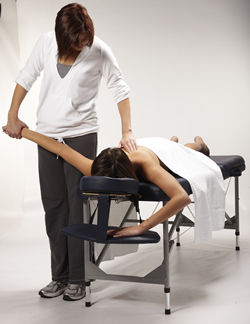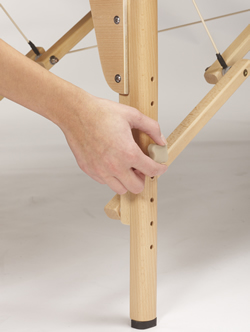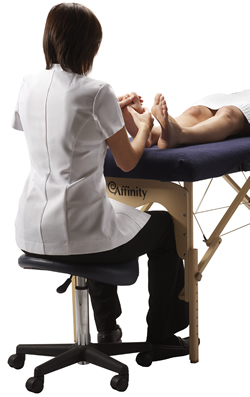Positive Health Online
Your Country

Not All Massage Tables Are Created Equal
listed in massage, originally published in issue 161 - August 2009
Even the most relaxing and skilfully executed treatment can be ineffective if the massage table is uncomfortable, creaks with the slightest movement or feels like it might collapse at any time. But these days, with many therapists having to leave the industry or reduce their activities as a result of a major or repetitive strain injury, ergonomics has become an increasingly important consideration for the therapist as well as the client.

Face Cradle
Choosing a massage table can be daunting; with so many to choose from, I often meet therapists who are concerned about spending their money on the wrong type of table. It is absolutely essential that you buy the table that is right for your business, and this includes ensuring that the table 'fits' you and will give you the best chance of avoiding unnecessary injury or discomfort.
Certain Factors Key to a Successful Purchase
Table Width
The width of a massage table is the measurement across the table between the two furthest points. It is usually expressed in inches. The 'ideal' width of a table is a matter of personal preference, so we recommend that you make your decision based on the following three key variables: The Treatments You Offer
Some treatments are better performed with a narrower table, particularly when strong pressure needs to be applied, such as deep tissue or sports massage. In this instance, the use of a narrower table offers a number of inherent benefits. Access to the lumbar area is more convenient, and thus a greater point load can be applied, resulting in a more effective treatment. The reduced leaning and stretching required to administer treatment is also beneficial for your long-term well being as a therapist.
Your Stature
There are two factors that should be taken into account in relation to your height: - Carrying the table
- Using it.
At the same time, a narrower table minimizes the risk of injury caused by excessive leaning across the table. A taller therapist will be able to reach further and can manage a wider table more comfortably.
Your Clients' Comfort
Wider couches are more comfortable for the client. Traditionally, 24" tables have been standard in the UK. These are fantastic from the therapist's point of view as they are often lighter and, for the shorter therapist, easier to carry. However, as a population we are following the trend of most industrialized nations by getting bigger. Clients 'spread' on a table more readily than perhaps they did 15 years ago and larger clients might find a narrower table disconcerting and less supportive.
It is therefore worth working out if you can manage with a slightly wider table. The most popular widths in the UK and Ireland these days are between 26" and 28".
Foam Thickness and Composition
The ideal foam density and depth for a table is dependent upon the type of treatments you wish to carry out. As a basic rule, when pressing into the couch with your hand, you should never be able to feel the wooden base though the foam.Sports and remedial treatments are better on a firm surface so that when pressure is applied, the force is not dissipated through a soft base. You want the foam to have enough rigidity to resist this pressure. By the same token, if you require extreme comfort for your clients, then choose a softer foam mix and a greater depth. This should supply comfort as well as support.
A mix of different foams arranged in layers, offering a good contrast of soft and supportive properties, is the best way to construct a quality massage table. Mid-range tables tend to be constructed in this way, whilst more expensive massage tables can be selected for more specific use. You should discuss your individual requirements with your specialist retailer.
Responsible manufacturers will offer flame retardant foam as standard and this is a good, indirect indicator of the quality of the supplier. If in doubt, you can ask to see a certificate.
Height Adjustment
Ensure your chosen table will adjust to the correct height for you and will close when set at this height. You should be able to adjust your table to match your inside leg measurement – so that your hip is level with the top of the foam-filled vinyl. Taller readers who need to set their table at full height should check whether it will remain stable when adjusted to the maximum. 
Height Adjustment
Some quality bespoke table manufacturers will make your table to a custom height. I would strongly advise against buying a table that is of fixed height and not made to your specifications. If you are not the right size for the fixed-height table, the extra stretching and reaching will have an adverse effect on your body, which may affect your earning power in the future.
Flat or Tilting
Tilting tables offer the option of lifting one section into a vertical position. Flat tables are always lighter than their tilting equivalents. Typically they vary by two to three kilograms. The reason is quite simple: if you consider a convertible car, in order for it to remain stiff and strong, the chassis must be strengthened. In the same way, the tilting massage table needs a stiffer sub-frame, and this of course adds to the weight. The lifting mechanism itself also adds weight to the table. If you do not need a lifting back rest, they are therefore best avoided, but if you envisage needing this feature in the future, it is best to invest in it from the outset.
Lifting Backrest Angle
Many tables only lift to 30°. Usually, a greater angle of movement is considered preferable. For example, in the case of a treatment such as reflexology, clients often prefer to sit up so that they can see their therapist and talk to them. At 30°, they will be staring at the ceiling or straining their neck to sit up. Therefore a table with a greater lifting angle is considered a better purchase, providing it remains stable.Lifting Mechanism
The lifting angle on a tilting table can be altered using one of two methods. The first is via a central pole attached to the backrest that slots through a bracket attached to the sub-frame of the table. I dislike this method for two reasons: the pole can make a scraping noise during adjustment but more importantly, the use of only one securing point in the centre of the tilting section means that the backrest is more liable to wobble. This will be less comfortable for the client.
The second method is the use of ratchets that are attached to each side of the lifting backrest. This usually allows for 10 different height settings that click into place. The drawback of this design is that when the lifting backrest is set it must be pushed all the way forward to return it to a flat position. This can be an inconvenience if the client is on the table at the time.
End Panels
End panels are the pieces of metal or timber that separate the legs of the table at the head and foot end. The selection of the appropriate end panel is a very important consideration for those therapists who treat their clients seated or who need close access to them. 
Reiki End Panels
From a manufacturer's point of view, the design of the end panel affects the stability of the table. End panels often take the shape of a piece of plywood, a metal bar or cross brace separating the two table legs at each end.
It is worth noting that the end panel is designed to maintain the stability of the couch, and is definitely not designed for the comfort of the therapist. The best arrangement for a seated therapist is 'Reiki end panels' that are designed with cut-outs that allow therapists to get their legs underneath the table when seated. This allows a therapist to sit closer, with a straighter back, thereby minimising the risk of workplace injury.
A Word of Caution
If you select a massage table with Reiki end panels, we recommend that you check out the design carefully. Reiki end panels by their very nature weaken the construction of a table because the bracing that keeps the legs apart occurs nearer to the top of the table which means it is harder for the table legs to retain their rigidity at the base. If this factor is not taken into account, the end panels can 'flex'. This not only dramatically reduces the strength of a table; but it also limits the type of treatments that can be offered and its overall lifespan.
If you are reasonably certain that you will not require this feature now or in the future, sticking to the older style end panels is a good option if your budget is limited.
Face Cradles and Armrests
This is the area where the client's head is positioned. It should be comfortable, supportive and not claustrophobic. Breathe Hole
A breathe hole is a hole cut directly into the middle of the top of one half of a table for the face. It is the traditional method of construction, works well and is still a popular choice for many therapists. However, having spoken to hundreds of therapists, I believe that the reason this style continues to sell well is more down to the fact that students often train on them and have little or no experience of the benefits of an adjustable face cradle.
A key reason for selecting this style is weight. If you are planning to be mobile, using a massage table with a breathe hole instead of a face cradle means that you will have the additional weight to carry. However, breathe holes can be quite uncomfortable and many clients find them claustrophobic.
Face Cradle
The adjustable face cradle is the horseshoe shaped cushion and matching stand that slots into the end of a table. There are three types of face cradle available: non-adjusting, single adjusting and double adjusting. (Non-articulating face cradles do not adjust and are not recommended). A single adjusting face cradle moves up and down and is more than adequate. The double adjusting face cradle has a similar mechanism, but also has a diagonal movement component as well. This provides additional movement but can be a little bit fiddly.
Up until two or three years ago, face cradles were seen as an expensive optional extra, certainly beyond the means of most therapists who were just starting out. Recently, prices have come down considerably with many manufacturers offering pack prices for under £200, which include cradles as standard.
There are several types of adjustable face cradle, but all styles are better for nearly all therapies than breathe holes.
With the addition of an armrest or sling, face cradles offer a number of inherent benefits for the client and the therapist alike:
- The length of the table is extended by up to 12 inches (30cm) This is much more pleasant for taller clients as their feet do not extend over the end of the table;
- The shoulder muscles are presented at the end of the table rather than 12 inches (30cms) down the table, allowing better access;
- With the addition of a sling or armrest, the rotary cuff muscles are turned and presented in the optimum position for massage;
- The armrest or sling also facilitates the opening of the scapula which makes for a better treatment.
Consider the Weight if you are a Mobile Therapist
To keep the weight down, if you can avoid buying a tilting table then I recommend you do so, as they nearly always add 2-3kgs in weight. If you only plan to be partially mobile, a heavier table may be feasible, particularly if your supplier offers a carry case with wheels. A truly portable table should weigh no more than 15kgs.Further Information
If you would like further advice on buying a massage table, please email therapyessentials@certikin.co.uk.For more information on the full range of Affinity massage tables, please visit www.therapyessentials.co.uk. To find your nearest retailer, please Tel: 0800 083 5530.
Comments:
-
Jude said..
Hi does anyone have or know where to get a face face cradle for massage couch with 16cm inner space between rods? A client lent on mine with all his weight and it broke - now cant use my couch. Have tried everywhere I can think , they all seem to be 18cm gap now. Many thanks